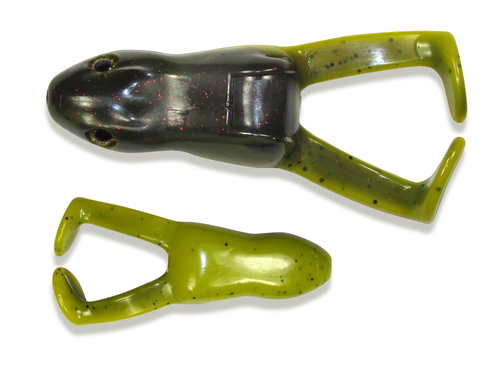Topwater fishing lures and techniques for fall fishing
When the days begin to get shorter and colder, most outdoorsmen start shifting their focus towards hunting.
Spring often gets the reputation for the best time of the year to fish with bass being active while preparing to spawn. Spring can offer some excellent fishing, but autumn offers some of the best topwater bass fishing all year. In this article, I will share some of my favorite techniques to catch big bass on the surface in the fall.
During the fall, several factors collide. Fish that have been out in deeper water start moving shallow as they prepare for the colder months ahead. These fish moving into the shallows compete for food with bass that remained shallow all year long. In addition, bass not only must compete with other bass, but an entire food chain trying to prepare for the approaching weather changes. This truly makes the water a “fish-eat-fish” type of world.
When approaching a body of water during the fall, keep a few things in mind. One of the first things to consider is the natural prey for that body of water. Shad live in just about every public fishery throughout the Southeast. With that in mind, it’s important to know what type of shad inhabits a particular body of water so you can match your bait to the shad you want to imitate.
Just because waters have shad for bass to eat, that doesn’t mean other topwater fishing lures won’t work just as well or better than something imitating a shad. Waters like the Mobile-Tensaw Delta have shad, but anglers can enjoy excellent action by fishing with topwater frogs and rats. These bait types typically work best in swampier areas or places with an abundance of vegetation, whether submerged grass or lily pads floating on top.
Many Topwater Temptations
In the fall of 2015, a lot of tournament anglers in the South Alabama Fall Collegiate Series depended on the early topwater bite to produce some of their largest fish. This worked well for both largemouth and spotted bass. Some anglers in the tournament placed their faith in a variety of “walk-the-dog” topwater fishing lures, buzzbaits, frogs and even some propbaits.
These baits proved to be the correct baits to land some nice fish. Some anglers fished these baits just long enough to secure their limit while others held their faith in these lures well past what most anglers consider the typical morning bite period. Bait placement for the later topwater bite proved to be crucial.
“During the fall, largemouth bass tend to bunch up because of one key component – bait.”
Once you have sized up the lake, river or wherever you’re fishing and you have some intel as to what type of prey you need to imitate, you must locate the fish! During the fall, largemouth bass tend to bunch up because of one key component – bait. Some fish will always be loners, but most of the time where you catch one bass there will be another one very close if not in the same spot. This is when it begins to get fun.
A good graph can be an essential tool for locating bait, but it is not the only sure way to know you’re in the correct spot. Simply take a moment and observe your surroundings. Sometimes, observation can prove to be one of the best things you can do. Look for disturbances on top of the water or birds congregated in a particular area as giveaways for where to find active fish. If anything, this time of year is beautiful and you’ve gotten a glimpse of some of the beauty that Mother Nature has to offer.
A favorite bait of mine for fall topwater fishing is a Strike King Sexy Dawg Jr. About the only modification I do to this bait is that I upsize the treble hooks to the next size. The oversized hooks tend to give me a better hookup ratio when fish are aggressive. This bait has a great action across the top of the water and produces a great sound.
The weight is evenly distributed and is excellent for casting long distances. Casting distance can come in handy for schooling fish so that you do not spook them. While they are very active and focused on eating, schoolies will disappear just as quickly as they showed up.
Getting the Equipment Right
Most people belief that topwater fishing lures should always be thrown on monofilament line, but this is where I have changed my setups. I like to throw “walk-the-dog” type baits on braided line. I use these baits for more of a search bait. The braided line has no stretch, which is great for a long distance hookset. It’s also still buoyant enough to float.
The rod is probably the most crucial aspect of this bait. I prefer to use a 7-foot, 2-inch medium action Myakka rod from Sixgill Fishing Products. With that rod, I use a 7:0.1 gear ratio Crius reel from the same company. This can really help you cover water quickly.
The next topwater fishing lures that I really like to use in the fall are the soft-plastic Ribbit Frogs from Stanley Jigs. This bait is somewhat a combination from the best of both worlds. Many anglers like to use a buzzbait. However, I feel this bait can be much more productive and has a little more versatility. Rigged weedless, a Ribbit Frog has very similar action to a buzzbait. An advantage of this bait over a traditional buzzbait, it can be skipped under docks and low hanging tree limbs. This technique just takes practice and some fine-tuning of the equipment.
When fishing this type of bait, I prefer a 7-foot, 3-inch Myakka medium-heavy action rod. This gives me some great castability with the backbone to handle large fish and just enough softness in the tip to allow for some premature hooksets.
Let’s face it. We all swing too early sometimes when bass are hitting topwater baits. I spool a Sixgill Hyperion reel with 65-pound test braided line so I have very little worry of line breakage.
Prop on Top
One bait anglers don’t usually see many people fishing these days is a propbait. The one in particular that I favor the most is a Smithwick Devil’s Horse. This is a large topwater bait with small propellers on each end. If fished properly, it can produce some big bites.
Anglers can choose from many other propbaits on the market as well. Typically, most of them have a single propeller on the back. I personally like to work these baits a bit slower. The rhythm that I use is just a series of slow methodical movements. With the tip of the rod, I move the bait just enough to get the blade to turn and put a small disturbance on top of the water.
Propbaits and popper type baits are about the only topwater fishing lures that I still use with monofilament. Typically, I use 14- to 17-pound test line. Monofilament line is crucial for a couple of reasons. One reason is because you want to have some stretch on the hookset. Another reason is that the monofilament provides enough flotation that it does not affect the action of the bait.
Fluorocarbon line tends to make these baits dive a bit, negatively affecting the bait. Braided line can be troublesome with it constantly getting tangled in the blades of propbaits. However, I do use pretty much the same setup with propbaits that I use for “walk-the-dog” type baits with the exception of the different line.
A Backup Plan
One last thing to keep in mind when using topwater fishing lures, anglers won’t always catch the fish. Sometimes, you may only get some reaction strikes. An important thing that I have learned is to always keep a soft-plastic bait handy. Typically, I will keep a 5-inch BK Swimbait, which is a soft-plastic minnow type bait from Netbait, rigged on a 1/8- to 3/16-ounce weighted hook. This allows me enough weight to cast it to the desired location, but it is light enough that the bait will slowly sink. If you’re having a lot of reaction strikes and no hookups this will usually entice them into thinking this is the baitfish they just wounded.
“One last thing to keep in mind when fishing topwater baits, anglers won’t always catch the fish.”
Some key factors that play into this approach are water temperature and cloud coverage. With the right water temperature and cloud coverage, it is possible to catch fish on topwater fishing lures all day long. Some anglers will get discouraged with fluctuations in air temperature. While I feel that air temperature can play a small part of whether or not bass will bite on top, I don’t feel that is the determining factor.
Just last year on the Mobile-Tensaw Delta, we faced a cold front with blistering cold winds and air temperatures in the 40s. However, the only bait we could catch fish on was a Devil’s Horse.
My rule of thumb is to give topwater fishing a try as long as the water temperature stays above 55 degrees. While many people argue that bass will not bite topwater fishing lures in water temperature below 60 degrees, I have consistently done well with water as cold as 54 degrees. You just have to alter your presentation a bit.
While anglers might use many different topwater fishing lures, these baits have proven to be successful for me throughout the years. Some of the baits I have mentioned may be unfamiliar to you, but hopefully, you can put together a fall topwater pattern for yourself from the tips in this article.
We each have our own fishing styles. If you can incorporate some topwater fishing in your arsenal, it might be just the ticket you need to land some trophy bass this fall.




